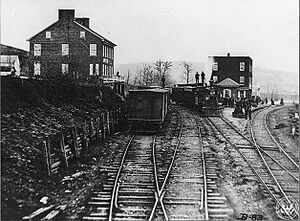Hanover Junction, Pennsylvania facts for kids
Quick facts for kids
Hanover Junction, Pennsylvania
|
|
|---|---|
|
unincorporated
|
|

Homes near Hanover Junction's railroad station in 1863
|
|
| Country | United States |
| State | Pennsylvania |
| County | York |
| Settled | 1851 |
| Area | |
| • Total | 0.3 sq mi (0.8 km2) |
| Elevation | 476 ft (145 m) |
| Time zone | UTC-5 (Eastern (EST)) |
| • Summer (DST) | UTC-4 (EDT) |
| Zip code |
17360
|
| Area code(s) | 717 |
Hanover Junction is a small community in York County, Pennsylvania. It's not an official town, but a "junction" where two important railroad lines met. Today, it's a popular rest stop on the York County Heritage Rail Trail.
The historic Hanover Junction Railroad Station is a key landmark here. Built in the 1850s, it was added to the National Register of Historic Places in 1983. This means it's recognized as an important historical site.
Contents
History of Hanover Junction
Hanover Junction began in 1851. It was created where the Northern Central Railway and the Hanover Branch Railroad lines crossed paths. Soon, a hotel and houses were built for travelers and railroad workers.
By 1853, trains were regularly arriving and departing. You could catch "The Accommodation Train" to and from Baltimore, Maryland. This train ran every day except Sundays.
Early Railroad Connections
In late 1858, the Gettysburg Railroad officially opened. Two trains left Gettysburg daily. One went to Hanover Junction to connect with trains heading to York, Harrisburg, Columbia, and Philadelphia. Another train left Hanover Junction to take passengers to Baltimore.
By the spring of 1859, express and mail trains were running between Hanover Junction and Baltimore. This made travel and communication much faster.
Hanover Junction During the Civil War
When the American Civil War started in April 1861, Hanover Junction became very important. Union Army soldiers from Pennsylvania often gathered here. They traveled south to protect Washington, D.C. and other areas.
As the war continued, more trains passed through Hanover Junction. They carried soldiers, horses, and supplies south. This made the junction a vital part of the Union's efforts.
In June 1863, Confederate troops moved into Pennsylvania. On June 27, they occupied Carlisle and threatened Hanover Junction. The town was still using telegraph to talk to state officials.
However, Confederate troops soon cut the telegraph wires. This stopped communication between York and Harrisburg. News reports said Confederate forces had reached the Northern Central Railroad.
A Quick-Thinking Act
During this time, a young man named John Shearer showed great courage. He quickly threw the telegraph key out a window. This kept the Confederate raiders from finding it.
After the troops left, he found the key and restored communications. This helped Union commanders talk to the War Department in Washington. People say he stayed awake at the telegraph key, powered by coffee.
After the Battle of Gettysburg
After the 1863 Battle of Gettysburg, Hanover Junction became a key route. Wounded soldiers were transported from Gettysburg. They went to hospitals in Baltimore, Harrisburg, and York.
A statue of President Abraham Lincoln stands here today. An historical marker also remembers Lincoln's visit. He changed trains at the junction on his way to deliver the famous Gettysburg Address.
Post-Civil War Railroad Changes
In May 1865, the Northern Central Railroad improved its line. A double track was finished between Baltimore and Hanover Junction. A new coaling depot was also built to fuel freight engines.
In the late 1800s and early 1900s, small businesses grew in the area. In 1872, a new railroad company was formed. It planned to build a new line from Hanover Junction to the Susquehanna River.
However, train travel became less popular in the mid-1900s. Because of this, the train station was eventually abandoned.
Hanover Junction Today
The Hanover Junction Railroad Station was added to the National Register of Historic Places in 1983. This helped protect its history.
In 2003, Hanover Junction was restored to look like it did during the Civil War. It reopened as a museum. Four Civil War cannons are also on display. They remind visitors of the area's role in the Gettysburg Campaign.



